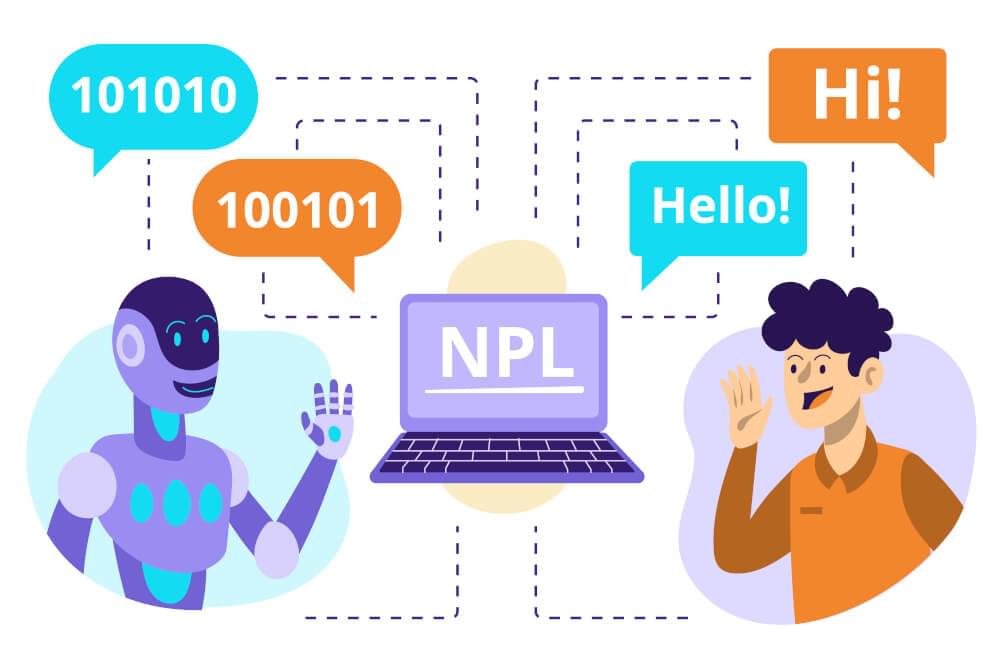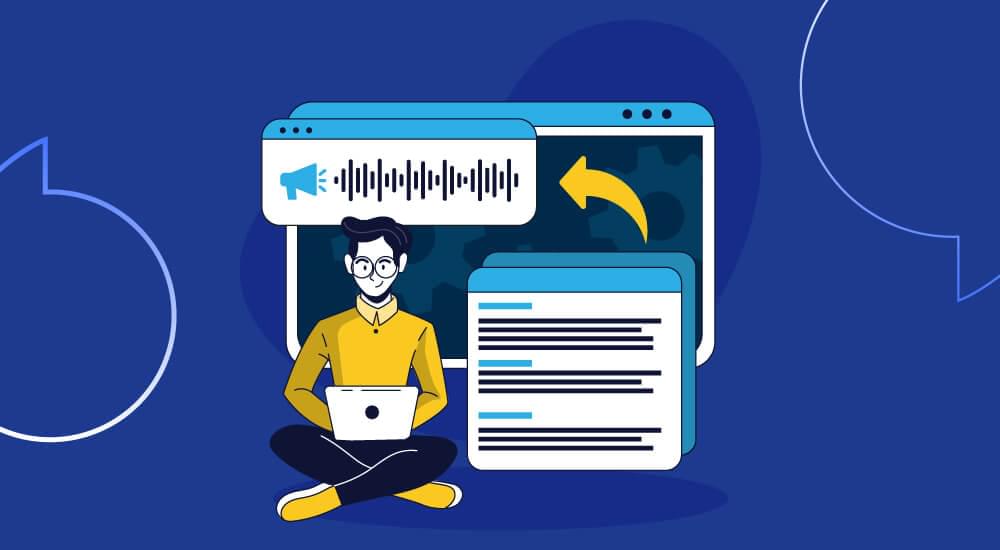voice technology tutorials
What is Natural Language Understanding (NLU)?
Automating operations and making business decisions helping them strengthen their brand identity, is the crux of the lives of the people in business.
NLU is a branch of AI that deals with a machine’s ability to understand human language. It includes both the spoken and written word. NLU(natural language understanding) is helping businesses achieve their goals-automation of repetitive tasks to attain quality results, achieving valuable information to make the best business decisions, and building more strong brand identity leading to more meaningful conversions.
The global natural language processing (NLP) market gained a value of USD 20.80 billion in 2021. It is expected to rise from USD 26.42 billion in 2022 to USD 161.81 billion by 2029, showing a CAGR of 18.1% during the forecast period.
NLU is a relatively new field, and as such, there is still much research to be done in this area. However, the potential applications of NLU are vast.
Some of the most promising applications of NLU include:
Improving human-computer interaction
Developing more natural and human-like conversational agents (such as chatbots)
Enhancing machine translation
Automating customer service tasks
Generating targeted content (such as ads or news articles)
As you can see, NLU has the potential to revolutionize several industries. And we are only just beginning to scratch the surface of what’s possibilities lie ahead of us.
Defining NLU (Natural Language Understanding)
What is NLU?
NLU is a branch of artificial intelligence that deals with the understanding of human language by computers. It is also known as natural language processing or NLP. NLU algorithms are used to process and interpret human language in order to extract meaning from it. They are used in various applications, such as chatbots, virtual assistants, and machine translation.

What are the different types of NLU?
There are two main types of NLU: rule-based and statistical.
Rule-based NLU uses a set of rules to interpret language. This approach is often used for small data sets and can be more accurate than statistical NLU. However, it is also more time-consuming to develop and maintain.
Statistical NLU uses statistical methods to interpret language. This approach is often used for large data sets and can be less accurate than rule-based NLU. However, it is also less time-consuming to develop and maintain technology.
What are the challenges of NLU?
One challenge of NLU is that human language is often ambiguous. For example, the same sentence can have multiple meanings depending on the context in which it is used. This can make it difficult for NLU algorithms to interpret language correctly.
Another challenge of NLU is that human language is constantly changing. New words are created and old words change meaning over time. This can make it difficult for NLU algorithms to keep up with the language changes.
The benefits of NLU that can help businesses automate operations
If you’re new to NLU, you probably would think of NLU (Natural Language Understanding) as something that only big tech companies like Google and Amazon use to empower their voice assistants. But the truth is NLU is becoming increasingly crucial for businesses of all sizes. Here are five benefits of NLU that you may not have considered:
1. NLU can help you better understand your customers.
If you’re looking for ways to understand your customers better, NLU is a great place to start. You can learn about their needs, wants, and pain points by analyzing their language. NLU is becoming a powerful source of voice technology that uses brilliant metrics to drill down vital information to improve your products and services.
In this fastest era, your business can’t rely on beliefs, hunchs, or theoretical analysis—you need a strong source of information that tells you everything about your target audience so you can make critical business decisions accordingly. NLU is transforming the business world at the fastest pace—quick to resolve problems, automate business tasks, generate a valuable source of information, automate product marketing strategy, and audience conversion into customers.
2. NLU can help you automate customer support.
NLU can be used to automate customer support tasks like answering FAQs and routing customer inquiries. This can free up your customer support team to focus on more complex issues.
NLU’s customer support feature has become so valuable for digital platforms that they can manage to offer essential solutions to customers and quickly transform the critical message to technical teams. AI-based chatbots are becoming irreplaceable as they offer virtual reality-based tours of all major products to customers without making them pay a visit to physical stores.
3. NLU can help you improve your marketing.
By understanding your customer’s language, you can create more targeted and effective marketing campaigns. You can also use NLU to monitor customer sentiment and track the effectiveness of your marketing efforts.
It strengthens your marketing game and gives your brand a solid voice. From giving a distinctive voice to your digital platforms, social media platforms, vlogs, audio blogs, and podcasts—one unique voice is enough to build a strong identity of your brand.
People in business are using voice technology to automate their content marketing strategy. In the past, creating content was an effort-prone and time-taking phenomenon. With the help of voice technology, creating audio blogs with one click is possible. According to research, the strength of the potential audience that listens to audio blogs is larger than the one who reads blogs. In the multi-tasking world, people need ways to consume content on the go, and audio blogs are the answer.
4. NLU can help you make better decisions.
NLU can be used to analyze unstructured data like customer reviews and social media posts. This information can be used to make better decisions, from product development to customer service.
The fastest and most intelligent metrics bring valuable information to the surface for you and your technical teams to review the facts and make critical business strategies accordingly.
5. NLU is only going to become more important.
As artificial intelligence (AI) continues to evolve, businesses that adopt NLU will have a competitive advantage. So if you still need to start using NLU, now is the time to explore its potential for your business.
You can begin by integrating text-to-speech plugins into your website. It will take one click to transform all text-based content into audio content—making web content accessible to everyone.
Once you add the audio button of audio blogs to your text-based blogs—all listeners would like to consume information from your website—making it easy for users to get information on the go.
You can convert audio blogs into podcasts later—enhancing the reachability of your website.
Use audio scripts for social media posts—bringing more engagement.
Using NLU’s AI-based metrics to drill valuable information on your users helps make better business decisions.
Using voice technology helps automate repetitive tasks—smoothing out complex business operations.
Audio chatbots help to resolve users’ problems—help in retaining customers.
Having useful information to improve your products and services brings more conversions.

3 EXAMPLES OF NLU (NATURAL LANGUAGE UNDERSTANDING)
If you’re like me, you probably think of NLU (Natural Language Understanding) as this really complicated thing that only big tech companies like Google, Amazon, and Facebook can do.
But the truth is, NLU is simple. In fact, there are many ways you can use NLU in your own life to make your life easier.
Here are 3 examples of NLU that you can use right now:
1. Automated customer service chatbots.
If you’ve ever used a chatbot on a website or app, then you’ve used NLU. Chatbots are powered by NLU algorithms that understand the user’s intent and respond accordingly.
2. Virtual assistants.
Virtual assistants like Siri, Alexa, and Google Assistant all use NLU to understand the user’s intent and fulfill their needs. For example, if you ask Siri to set a timer for 5 minutes, she uses NLU to understand that you want her to set a timer for 5 minutes.
3. Search engines.
Search engines like Google use NLU to understand what you’re looking for when you type in a query. Google then uses this information to provide you with the most relevant results.
These are just a few examples of how you can use NLU in your everyday life. So next time you come across a chatbot or search engine, remember that there’s some pretty amazing NLU technology powering it!
The development of NLU in intelligent technology
1. Automated Reasoning
In the early days of Artificial Intelligence (AI), researchers focused on creating machines that could perform specific tasks, such as playing chess or proving theorems. This was known as AI’s “narrow” focus. However, in recent years, there has been a shift to a “broad” focus, which is aimed at creating machines that can reason like humans.
One area of research that is particularly important for broad AI is Natural Language Understanding (NLU). This is the ability of a machine to understand human language and respond in a way that is natural for humans.
NLU is a difficult problem because human language is ambiguous and often contradictory. For example, the sentence “John is taller than Bill” can be interpreted in two ways: either John is taller than Bill, or Bill is taller than John.
Automated reasoning is the process of using computers to reason about something. However, automated reasoning can help machines to understand human language. In the case of NLU, automated reasoning can be used to reason about the meaning of human language.
There are many approaches to automated reasoning, but one of the most promising is known as “neural symbolic reasoning”. This approach combines the power of neural networks with the symbolic representations used in traditional AI.
Neural networks are a type of machine learning algorithm that is very good at pattern recognition. They can be trained to recognize patterns in data, such as images or text.
Symbolic representations are a type of representation used in traditional AI. They are based on symbols that represent concepts, such as “taller” or “John”. Symbolic representations are often used in rule-based systems, which are a type of AI that uses rules to infer new information.
The neural symbolic approach combines these two types of AI to create a system that can reason about human language. The neural part of the system is used to understand the meaning of words and phrases, while the symbolic part is used to reason about the relationships between them.
The neural symbolic approach has been used to create systems that can understand simple questions, such as “What is the capital of France?”. However, it is still early days for this approach, and more research is needed before it can be used to create systems that can understand more complex questions.
Despite this, the neural symbolic approach shows promise for creating systems that can understand human language. Automated reasoning is a powerful tool that can help machines understand human language’s meaning.
Also, read:
10 Tips To Make Journalism Accessible With A Text-To-Speech Software
2. Machine Translation
Machine translation of NLU is a process of translating the inputted text in a natural language into another language. This can be done through different software programs that are available today. In order to have an effective machine translation of NLU, it is important to first understand the basics of how machine translation works.
The first step in machine translation is to analyze the inputted text. This is done by breaking down the text into smaller units, such as sentences or phrases. Once the text has been analyzed, the next step is to find a corresponding translation for each unit in the target language. This can be done by using a dictionary or database of translations.
Once the translations have been found, the next step is to put them back together to create a new text in the target language. This new text should be checked for accuracy and clarity before it is finalized.
Machine translation of NLU can be a valuable tool for businesses or individuals who need to quickly translate large amounts of text. It is important to remember that machine translation is only sometimes 100% accurate and some errors may occur. If you are using machine translation for critical documents, it is always best to have a human translator check the final document for accuracy.
3. Automatic Ticket Routing
NLU is often used to automate customer service tasks. When a customer service ticket is generated, chatbots and other machines can interpret the basic nature of the customer’s need and rout them to the correct department. Companies receive thousands of requests for support daily, so NLU algorithms are useful in prioritizing tickets and enabling support agents to handle them more efficiently.
Its wrap-up
The only answer to achieve multiple benefits is WebsiteVoice. It’s text-to-speech software that is the answer to all business needs. AI-based text-to-voice software helps businesses automate their business tasks, create product marketing strategies and make the best business decisions—a one-platform solution within budget no matter the big or small industry you deal in.









